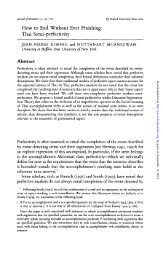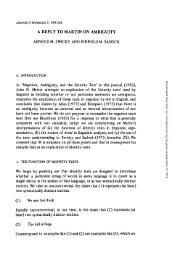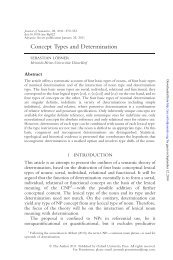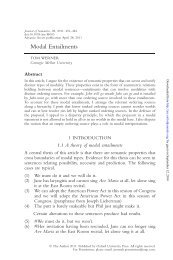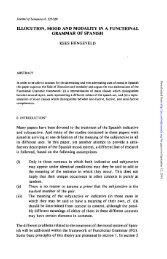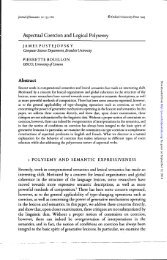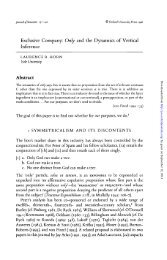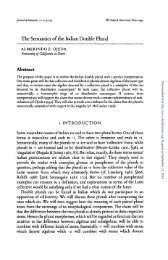Lexical Pragmatics - Journal of Semantics
Lexical Pragmatics - Journal of Semantics
Lexical Pragmatics - Journal of Semantics
Create successful ePaper yourself
Turn your PDF publications into a flip-book with our unique Google optimized e-Paper software.
148 <strong>Lexical</strong> <strong>Pragmatics</strong>proposition B. For example, if we strengthen eg by adding ->B (as in (30), Swill be pragmatically anomalous in the new context. This shows that on thecurrent account cancellability is not a necessary feature <strong>of</strong> conversationalimplicature; some implicatures may be non-cancellable. The Hobbs-Stickelapproach, on the other hand, is in agreement with the standard view(resting on the highly defeasible notion <strong>of</strong> minimal explanation).The usefulness <strong>of</strong> cancellation as a test for conversational implicature hasbeen challenged in connection with the thesis 4 <strong>of</strong> section 3.2. The presentaccount <strong>of</strong> conversational implicature suggests that a proper treatment <strong>of</strong>conversational implicature may explain when an implicature is cancellableand when not. The next subsection provides an analysis <strong>of</strong> the pragmatics <strong>of</strong>adjectives that gives further evidence for this view.4.2 Abduction and the pragmatics <strong>of</strong> adjectivesOne part <strong>of</strong> speech is especially suited to demonstrating the phenomenon <strong>of</strong>semantic underspecification: the adjective. In section 2.1 we considered thefree variable view as an especially promising account <strong>of</strong> treating the meaning<strong>of</strong> adjectives. It had been stressed that the specification <strong>of</strong> free variables isnecessary for a full interpretation <strong>of</strong> an utterance. I will now demonstratehow the current theory yields an appropriate mechanism <strong>of</strong> (contextual)specification by applying it to the kind <strong>of</strong> examples discussed by Quine(i960) and Lahav (1993) (cf. section 2.1).(32) (a) The apple is red(b) Its peel is red(c) Its pulp is red(d) APPLE(d) A PART(d,x) A COLOUR(x,u) A u = red(e) APPLE(d) A PART(d,x) A PEEL(x) A COLOUR(x,u) A u = redMy claim is that (32b) but not (32c) can be construed as a conversationalimplicature <strong>of</strong> (32a). Input <strong>of</strong> the analysis is the underspecified semanticrepresentation given in (32d). One <strong>of</strong> the abductive specifications <strong>of</strong> thissemantic input specifies x as the peel part <strong>of</strong> the apple (see (32c)). For thecalculation <strong>of</strong> the corresponding costs we start with assumption costs asgiven in the first line <strong>of</strong> (3 3). Note that we take the assumption cost forthe 'slots' PART(d.x) and COLOUR(x,u) as negligible with regard to thecosts <strong>of</strong> the more 'specific' elements <strong>of</strong> the representation. 17 This contrastswith corresponding stipulations by Hobbs et al. (1993) but it agrees withthe general picture that specificity is the primary determinator <strong>of</strong> theassumption costs. Furthermore, we refer to axioms <strong>of</strong> the formareq



